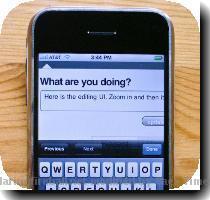Tweet, tweet: Olympic updates coming from little birdies, or Facebook at the Twitter Olympics
By Eddie Pells, APWednesday, February 10, 2010
Getting the message out in 140 characters or less
VANCOUVER, British Columbia — What if the Miracle on Ice players had Twitter accounts?
Or if the sprinters who raised their gloved fists on the medal stand could have shared their thoughts on Facebook?
Thanks to laptops, cell phones and other new technology, social networking could be the route the next transformative Olympian uses to get the word out.
Skaters, skiers, hockey players and the reporters who cover them now have almost instant access to their fans and readers at what has long been, for better and worse, one of the most grandiose stages for message-sending.
When the torch is lit Friday, it will mark the beginning of the Twitter Olympics era — the first games where social networking and sports collide on a global platform that only the Olympics can provide.
“I’m sure I’ll be flooding tons of photos and tons of stories and glimpses from behind the scenes,” said Shaun White, the defending Olympic halfpipe gold medalist. “Because, really, what an interesting and cool time to be sharing with everyone.”
White is among the hundreds of athletes who have Twitter and Facebook accounts — or spaces on similar sites — with plans to use them over the 17-day sports festival.
They will give friends, family, fans and, yes, reporters updates on their training and competition, random musings, pictures, links to their Web sites and other peeks behind the Olympic curtain that the public can’t usually see.
It will save them time on the phone, help them build their fan base and allow them to get their message out, unfiltered by the so-called traditional media. It might also serve up a bit of instant gratification when the grind of training and waiting takes its toll.
“I’m not a full addict like some people are,” said American Nate Holland, one of the favorites in snowboardcross, a sport added to the Olympic program to appeal to the same, young demographic that inspired the social networking boom.
“But I like to give updates and definitely get those out to people,” Holland said. “I can just Facebook ‘Best course ever,’ and 20 minutes later there are a ton of replies and people cheering you on. It strokes the ego a little bit.”
Meanwhile, the traditional media is using social networking to try to build audiences that have been fragmenting of late. Reporters from The Associated Press, for instance, will be tweeting from venues and using those posts to link readers to stories on hundreds of customers’ Web sites. The AP also has a Winter Olympics Facebook page that includes a mix of stories from its traditional wire service and short blog entries from on-site reporters.
“Like many media companies, we are trying new methods to disseminate and gather information — in this case from athletes and others attending the Olympics,” said Lou Ferrara, AP’s managing editor for sports, entertainment and interactive media. “We want to give the audience what it wants and where they want it.”
Of course, with technology comes confusion, and there’s already been some of that.
Knowing the social networking craze was coming, the International Olympic Committee put out a four-page blogging guideline that supplements Rule 49 of the Olympic charter, which essentially states that only journalists can act as journalists at the games, while athletes and coaches cannot.
The addendum says blogs are permitted, so long as they are diary-like in nature, don’t include live action or ceremonies and don’t give “newsy” updates, such as injury reports or information about rivaling countries.
Bob Condron, spokesman at the U.S. Olympic Committee, said Twitter posts — with their abbreviation-inducing 140-character limits — are considered allowable by the IOC, which didn’t specifically mention that site in its rules.
“The IOC considers blogging, in accordance with these Guidelines, as a legitimate form of personal expression and not as a form of journalism,” the rule states.
Prohibited in that personal form of expression, however, are any attempts to promote non-Olympic sponsors — a sticking point between the Olympic powers and the athletes who often struggle to cash in on the success of their Olympic journeys.
Oh, and there is the ever-present reminder not to use the Olympics as a political stage — a rule that has long been the crux of a sticky debate about whether the Olympics are just a simple sports festival, or something much more.
“It was pretty crazy to see what we are not allowed to do or supposed to say,” said short-track speedskater J.R Celski, a frequent tweeter. “No advertising and just making sure you are positive, but it’s understandable.”
Lindsey Vonn recently told her 35,000-plus followers that she would not be posting Twitter updates because of Olympic blackout rules — then came back a day later and said she would.
“Contrary to what I was told it turns out that I am allowed to continue to tweet and facebook during the Olympics!!” she wrote on Facebook. “Yay!! I have to follow very specific rules though:( Did you guys really think you were going to get rid of me that easily?! I’m back baby!”
But when news of her injured shin broke — an update that could not only impact her, but the entire tenor of the Olympics — there was no mention of it on her Twitter feed. Instead, Vonn revealed the news in an interview with NBC, which bankrolls the Olympic movement to the tune of $2 billion over four years.
While Vonn graces the cover of Sports Illustrated and has sponsors aplenty, athletes such as Jeret “Speedy” Peterson are always looking for ways to get the word out. Peterson, the aerials skier whose trademark “Hurricane” jump could give him his 15 minutes of fame come Feb. 22, is at 2,000 fans and climbing on Facebook — and knows the Olympics could be his last, best chance to augment the fan base.
“It’s free, it’s instantaneous and it’s real,” he said. “It’s my message and it’s not filtered. That kind of convenience is a huge thing for people.”
Convenient as it can be, a surprising number of athletes said they wanted to enjoy the experience without laptops and cell phones getting in the way.
“I want to give my country respect and be involved in the moment and soak it up as much as I can,” said snowboardcross rider Lindsey Jacobellis.
Many athletes insist that, once the games start, their actual performance — not updating people about their performance — must come first. But that doesn’t mean they won’t have anything to say.
“It’s like an instantaneous thought of what you are doing on the move, usually from your cell phone, so it’s a very kind of short, pure, raw view of what people are up to,” said U.S. Nordic combined skier Billy Demong, who recently bought a helmet-cam so he could post video of his training.
By doing whatever they have time for, it’s almost a sure thing that more information will be available in more formats. Heck, even the IOC Web site has links to Twitter and Facebook.
What has yet to be seen is whether the information will spark something transformative — think sprinters John Carlos and Tommie Smith raising their fists on the podium in the pre-cell-phone days of 1968 — or wind up only as more noise in the machine.
“I guess they have the opportunity to express their feelings and emotions on the computer,” Carlos said. “That in itself would be a statement made. But my thing was very clear. I don’t know if they could express the statement we made in Mexico on the computer.”
AP Sports Writers Pat Graham and Howard Fendrich contributed to this report.
Tags: British Columbia, Canada, Computing And Information Technology, Corporate Sponsorship, Events, Geography, Internet Technology, Lindsey vonn, North America, Online Media, Relationships, Skiing, Snowboarding, Sports Business, Sports illustrated, Sports Names, Sports Topics, Vancouver, Winter Olympic Games, Winter olympics, Women's Sports


